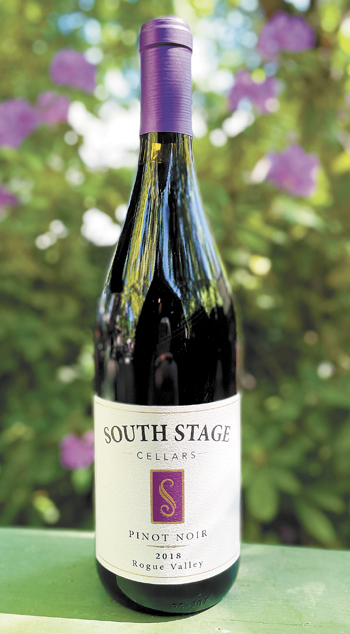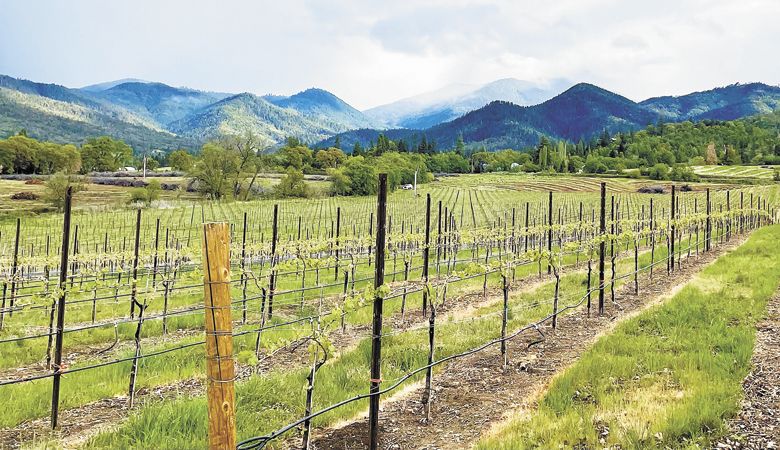A Fiery Fable
Rebuffed, smoke-exposed Pinot wins gold
There was a baptism by fire and smoke Labor Day last year as nearly 40 wind-fueled blazes engulfed Oregon for two weeks. Part of an epic West Coast wildfire season, the experience proved a terrifying, jarring wake-up call, especially for the usually clear-skied Willamette Valley. South in the Rogue Valley, growers and winemakers have been hammered periodically with heavy regional smoke for a decade, most intensely in 2018. They’ve learned to deal with it.
As the new year’s fire season approaches, let’s raise a glass to a notable outcome worth discussing: Rogue Valley’s Quail Run Vineyards won a gold medal at the 2021 McMinnville Wine Classic Competition for its South Stage Cellars 2018 Pinot Noir. The fact that the Southern Oregon winery produced an award-winning wine is not unusual; the region’s quality rivals any appellation in the state. What’s remarkable is this particular wine was made from fruit rejected by the buyer after testing for smoke — specifically, light-to-moderate smoke penetration into the skin and pulp.

Quail Run also captured the event’s top honors with its 2019 South Stage Cellars Romeo & Juliet, a white blend, in Best White Wine and Best of Show categories. But it was the gold medal that underscored something greater than just a superb wine. The win was a heads-up to growers and winemakers who jettisoned similar fruit in 2020 because of smoke unknowns.
Smoke exposure doesn’t always mean smoke taint
Michael Moore is vineyard manager for Quail Run in Talent, where he oversees 13 Rogue Valley vineyards. He was surprised when he heard about the Copper Cane rejection because of elevated guaiacol, one of two major volatile phenols from smoke impact. His immediate concern was not necessarily with the cancellations but their timing.
“[Rejecting the fruit] was their fair decision,” he said, adding, “but they waited to cancel, which meant fruit was too ripe to sell to other buyers.” So Moore presented his winemaker, Eric Weisinger, with the grapes measuring 26.3 Brix — too high for many winemakers.
No problem for Weisinger.
“The fruit had smoke exposure, but not to the point of being unusable,” he explained. “Overall fruit quality was excellent. These were good grapes from the Bayliss Vineyard.”
Moore concocted an idea after recalling the trials Barrel 42, a custom-crush facility in Medford, had completed with smoke-exposed grapes. “They had Cabernet Franc from a very smoky 2016 vintage and took a low-tech approach of adding untoasted oak chips during primary fermentation. Nothing more. So when I sent our over-ripe fruit to Eric, I asked him to follow the same protocol. No enzymes, no RO (reverse osmosis), no centrifuges. Just untoasted chips. That was it.” Weisinger agreed and followed through.
The result? A gold-winning Pinot.
“The 2018 vintage was really smoky for all of us in the Rogue Valley,” Weisinger explained. “The key things we found we could do in production to mitigate smoke exposure were oak chips, extended macerations and
going gentler on the press.”
He continued, “When you have smoke exposure, you can’t remove it. It’s always going to be there. But you can isolate it and use methods to call attention to other flavor and aroma components, not the smoke.”
In addition, smoke researchers at UC Davis, the University of Washington and Oregon State University confirm what Oregon growers, also veterans of California’s fire seasons, have been advising their colleagues: Don’t worry so much.
Unless a vineyard is close or downwind to a fire, fruit will likely be usable. Although fruit will absorb smoke drifting in from distant origins, it’s primarily inconsequential, even when it hangs in the air for several weeks.
Experts urge growers: Regardless of the smoke scenario, the most effective tool when smoke arises is to assess the hanging fruit. “Look at the numbers you get from [testing] and act on it quickly,” Weisinger advised. “Go with your gut feeling. Chances are good you have fruit that can be used. Just because there’s smoke in the air doesn’t mean there will be smoke taste or aroma in your wine.” He added: “The big story with our award-winning 2018 Pinot Noir was the fact it had no smoke taste or aroma at all.”
Smoke task force to release new guidelines
For winemaker Nichole Schulte, one of the partners at Barrel 42, becoming one of Oregon’s experts on smoke and wine grapes originated from necessity at the custom-crush facility. “In recent years, more and more winemakers have asked us how to deal with smoke,” she said. So she took it upon herself to delve into smoke education. For two years, she’s been a member of the West Coast Smoke Exposure Task Force, formed by organizations in Oregon, Washington and California.
The group is busy putting final touches on a new set of best-practice guidelines tailored to the specific circumstances and needs of local wine producers. “Our goal is to get that in the hands of growers before harvest this year,” Schulte explained. It will be a summation of findings from the three Northwest universities actively involved in smoke research, data from labs who perform smoke testing for Oregon growers and assistance through a number of avenues from the Australian Wine Research Institute.
Schulte gives special praise to the Aussies: “They’ve been at this a long time and know their smoke,” she said. “While combustibles in Australia are completely different (brush instead of trees, which makes a huge difference), their processes, procedures and protocols developed over the years are invaluable, and we’re adapting a lot of those that make sense here.”
On the legal end of the smoke issue lies the conditional acceptance clause in fruit contracts, favoring opt-outs for buyers. Moore makes a valid point that growers are much too vulnerable to a buyer’s arbitrary perceptions and whims. Tackling this issue will require all of Schulte’s legal skills as a former litigator.
“Things have to change to make it fairer to the growers,” she said. “We need to get growers and wineries together to work this out. Is it the grower’s fault for smoke in the air? The buyer’s fault? Of course, it’s neither. This is an increasing issue, and both sides have to come together and reach an agreement on how best to deal more equitably with the situation.”
A mounting PR quandary
As wineries, undoubtedly, make future wines from exposed fruit — note: smoke exposure and smoke taint are not interchangeable — they must communicate strategic messaging to customers and the media.
“Winemakers will need to learn their talking points on this issue,” said McMinnville Wine Classic Competition co-organizer Carl Giavanti. “This is a reality that won’t go away. It’s not a negative thing; it’s just a reality. We need to talk about it and, in some ways, embrace it.”
Schulte offers an astute observation: “Smoke is pleasant to us. We put smoke flavors intentionally into our foods and in our wines via smoke-charred barrels, so a little smoke is not a bad thing.”
In response to evaluating a wine heavily affected: “Yes, I’ve tasted wine that is actually smoke tainted. It’s awful. It really does taste and smell like a cigarette butt-cluttered ashtray. There’s no way you can miss it. And you really want to avoid it.”
A word on smoke-exposed wine
West Coast Smoke Exposure Task Force member and Barrel 42 co-partner Nichole Schulte has some heads up words for wine lovers in the context of fire and smoke.
1) Understand. Wildfires are natural occurrences that are necessary to many ecosystems. The effects of climate change may be exacerbating the frequency of wildfires.
2) Trust. Your winemakers are determined to put quality wines in bottles. They rely on the prowess of researchers, experience of generations of winemakers past, and the creativity that leads to enjoyable and interesting wines.
3) Enjoy. Wine is a reflection of a time and place. As you sip, contemplate the efforts of the winegrowers, winemakers, those that tend the fields and those that care for the barrels.













